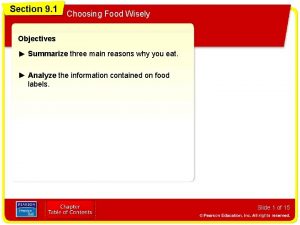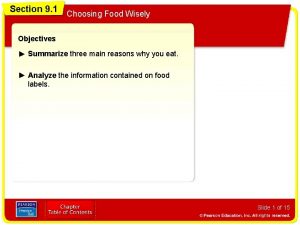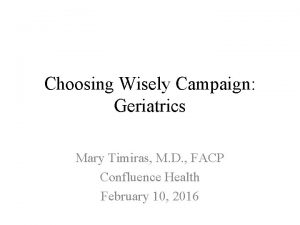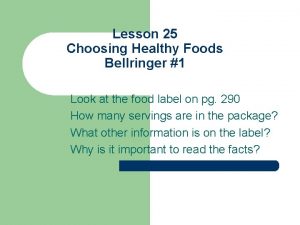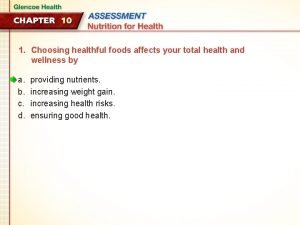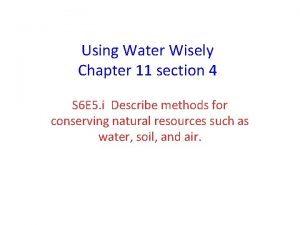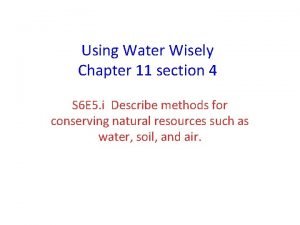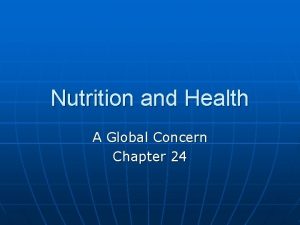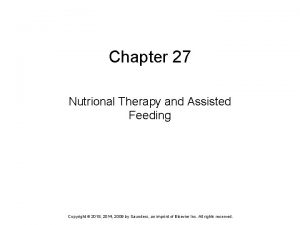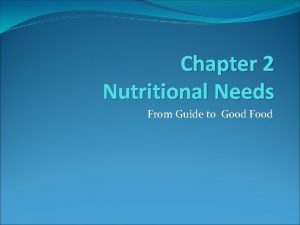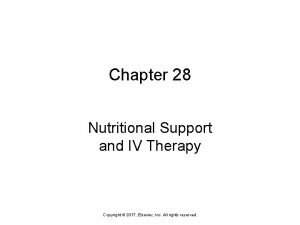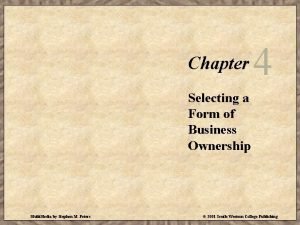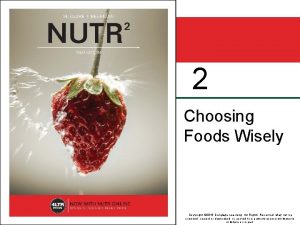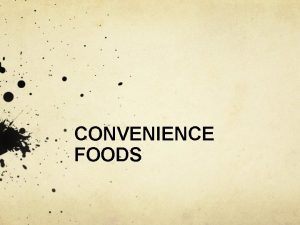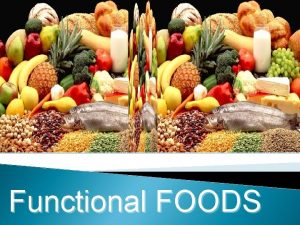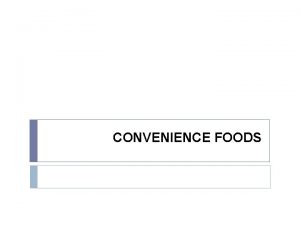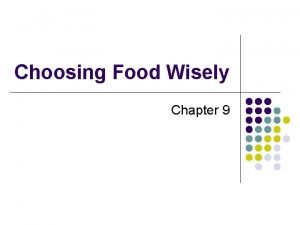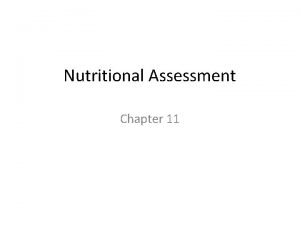Choosing Foods Wisely Chapter 02 What Is Nutritional




























- Slides: 28

Choosing Foods Wisely Chapter 02

What Is Nutritional Status? • Undernutrition • Inadequate intake of nutrient or energy • Nutritional deficiency • Overnutrition • Nutritional toxicity • Nutritional status • Malnutrition

What Is Nutritional Status? • Malnutrition • Primary malnutrition • Inadequate diet • Secondary malnutrition • Treatment • Adequate nutrient intake • Influential factors • Nutritional accuracy

Dietary Intake Influences Nutritional Status & Health

How Is Nutritional Status Assessed? • ABCD methods of nutritional assessment • Anthropometric measurement • Physical dimensions and composition • Easy and inexpensive • Height and weight • Circumferences • Body composition • Amount and distribution

How Is Nutritional Status Assessed? • ABCD methods of nutritional assessment • Biochemical measurement • Lab analysis of biological sample • Clinical assessment • Medical history • Signs • Symptoms

How Is Nutritional Status Assessed? • ABCD methods of nutritional assessment • Dietary assessment • Diet recall • Food frequency questionnaire • Diet record or food record • Food composition tables and dietary analysis software

How Much of a Nutrient Is Adequate? • Dietary Reference Intakes (DRIs) • Set of four dietary assessment standards • Life stages • 16 for females and 10 for males • Nutrient requirement • Amount that must be consumed for optimal health Factors that influence nutrient requirements •

Dietary Reference Intake Standards

How Much of a Nutrient Is Adequate? • Estimated Average Requirements (EARs) • Meets physiological requirement of half of • • healthy people Not available for all nutrients Cannot be used for individuals • Recommended Dietary Allowances (RDAs) • Derived from EARs • Used for individuals • Not available for all nutrients

Comparing EARs to RDAs

How Much of a Nutrient Is Adequate? • Adequate Intake levels (AIs) • Not enough evidence to establish EAR • Only AIs for life stage birth to 6 months • Tolerable Upper Intake levels (ULs) • Highest level of usual daily intake likely to be safe

Using DRI Values to Assess Nutritional Status

How Much of a Nutrient Is Adequate? • Estimated Energy Requirement (EER) • Average intake to maintain a healthy weight • Influential factors • Physical activity • Mathematical equations

How Much of a Nutrient Is Adequate? • Acceptable Macronutrient Distribution Ranges (AMDRs) • Carbohydrates • 45 to 65 percent of total energy • Proteins • 10 to 35 percent of total energy • Fats • 20 to 35 percent of total energy

How Can You Assess and Plan Your Diet? • USDA food patterns • Categorize nutritionally similar foods • Recommendations for number of servings • Currently five food groups • Dietary Guidelines for Americans • Incorporate USDA food patterns

How Can You Assess and Plan Your Diet? • 2010 Dietary Guidelines for Americans • Important facts • Obesity epidemic • Physical inactivity and poor diet • Inability to acquire adequate food • Overarching goals • Help maintain energy balance over time • Help choose nutrient-dense foods

How Can You Assess and Plan Your Diet? • 2010 Dietary Guidelines for Americans • Four groups of recommendations • Balance calories to manage weight • Strategies • Reduce consumption of certain foods & food components • Foods and food components of concern • Strategies

How Can You Assess and Plan Your Diet? • 2010 Dietary Guidelines for Americans • Four groups of recommendations • Increase consumption of certain foods and nutrients • Potassium, dietary fiber, calcium, & vitamin D • Nutrients for certain populations Build healthy eating patterns • Key recommendations •

How Can You Assess and Plan Your Diet? • USDA Food Patterns • Twelve eating patterns • Kinds of foods and proportions • Based on caloric needs • Five food groups • Nutrient density • Examples • Beverage intake • Recommendations

How Can You Assess and Plan Your Diet? • My. Plate • Visual food guide • Replaced My. Pyramid • Daily food plans • Four basic themes • Build a healthy plate • Cut back on… • Eat the right amount of calories for you • Be physically active your way

The USDA My. Plate Graphic

An Example of a Daily Food Plan

How Can You Use Food Labels to Plan a Healthy Diet? • Required information on a food label • Nutrition Facts panel • Nutrient content of the food • Critical elements mandated by FDA • Daily Values • Two types • Nutrient’s recommended daily intake • Nutrient’s upper limit • “Good source”

Understanding Food Labels & Nutrition Facts Panels

How Can You Use Food Labels to Plan a Healthy Diet? • Nutrient content claims • How much of a nutrient is in a food • Health claims • Potential health benefits of foods or food • • components Must be approved by FDA Two kinds of health claims • Regular health claim • Qualified health claim

FDA-Approved Nutrient Content Claims

Can You Put These Concepts into Action? • Step 1: Set the stage and set your goals • Step 2: Assess your nutritional status • Step 3: Set the table to meet your goals • Step 4: Compare your plan and your assessment
 Choosing foods wisely quiz
Choosing foods wisely quiz Choosing food wisely
Choosing food wisely Choosing wisely geriatrics
Choosing wisely geriatrics Lesson 25 choosing healthful foods
Lesson 25 choosing healthful foods Which method of preparation tends to make food high in fat?
Which method of preparation tends to make food high in fat? Chapter 11 section 4 using water wisely answer key
Chapter 11 section 4 using water wisely answer key Using water wisely
Using water wisely It is a practice of using resources wisely
It is a practice of using resources wisely Wisely using resources to achieve goals is known as
Wisely using resources to achieve goals is known as Iambic pentameter othello
Iambic pentameter othello 4.3 using studies wisely
4.3 using studies wisely Lucrativae
Lucrativae Helen leathem
Helen leathem Wisely wicked
Wisely wicked Wisely definition
Wisely definition Chapter 24 nutritional care and support
Chapter 24 nutritional care and support Chapter 27 nutritional therapy and assisted feeding
Chapter 27 nutritional therapy and assisted feeding Chapter 2 nutritional needs
Chapter 2 nutritional needs Chapter 28 nutritional support and iv therapy
Chapter 28 nutritional support and iv therapy Chapter 28 nutritional support and iv therapy
Chapter 28 nutritional support and iv therapy Chapter 28 nutritional support and iv therapy
Chapter 28 nutritional support and iv therapy Chapter 1 choosing your career
Chapter 1 choosing your career Business ownership
Business ownership Chapter 4 choosing a form of business ownership
Chapter 4 choosing a form of business ownership Chapter 21 lesson 2 choosing to live alcohol free
Chapter 21 lesson 2 choosing to live alcohol free Chapter 20 lesson 2 choosing to live tobacco free
Chapter 20 lesson 2 choosing to live tobacco free Valoarea nutritionala a alimentelor
Valoarea nutritionala a alimentelor Nutritional habits for hypnum sp
Nutritional habits for hypnum sp As nutritional energy passes through the food chain it is
As nutritional energy passes through the food chain it is
